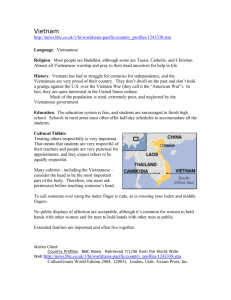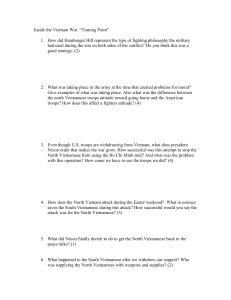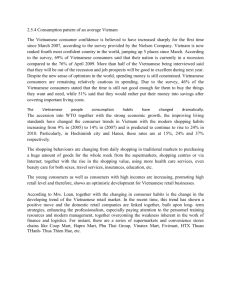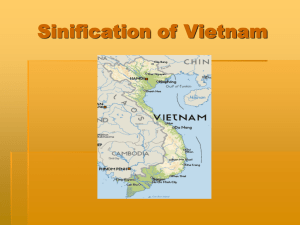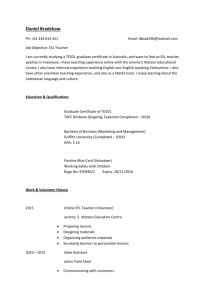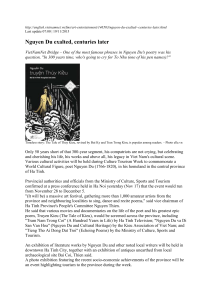(N) Tale of Kieu (1/3)
advertisement
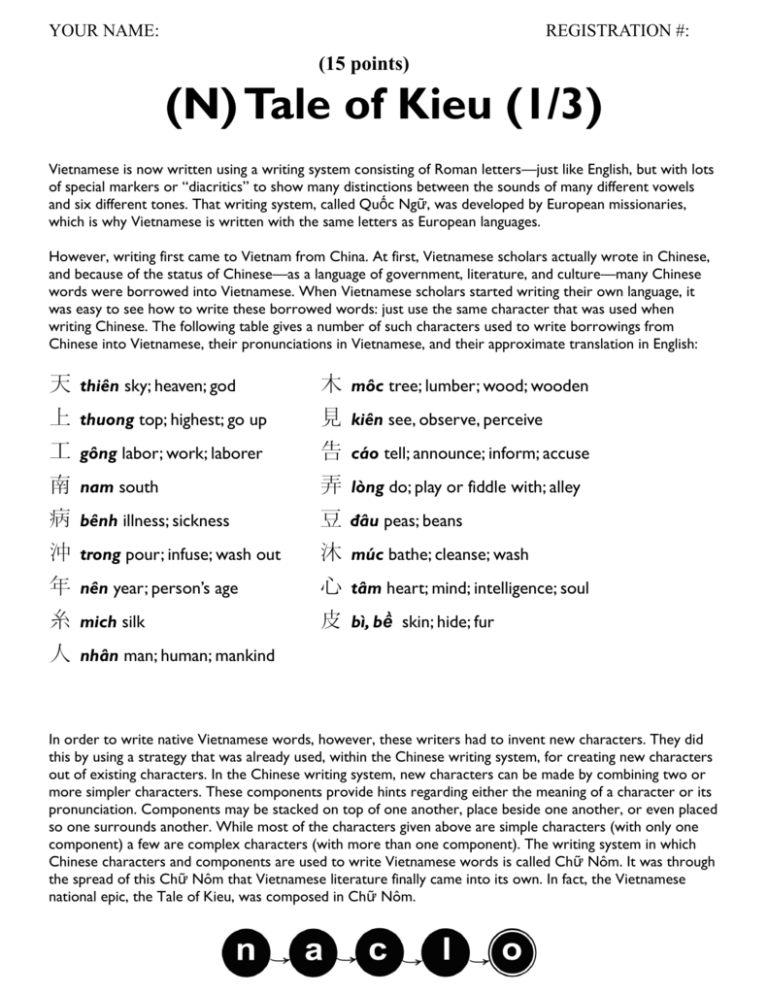
YOUR NAME: REGISTRATION #: (15 points) (N) Tale of Kieu (1/3) Vietnamese is now written using a writing system consisting of Roman letters—just like English, but with lots of special markers or “diacritics” to show many distinctions between the sounds of many different vowels and six different tones. That writing system, called Quốc Ngữ, was developed by European missionaries, which is why Vietnamese is written with the same letters as European languages. However, writing first came to Vietnam from China. At first, Vietnamese scholars actually wrote in Chinese, and because of the status of Chinese—as a language of government, literature, and culture—many Chinese words were borrowed into Vietnamese. When Vietnamese scholars started writing their own language, it was easy to see how to write these borrowed words: just use the same character that was used when writing Chinese. The following table gives a number of such characters used to write borrowings from Chinese into Vietnamese, their pronunciations in Vietnamese, and their approximate translation in English: 天 上 工 南 病 沖 年 糸 人 thiên sky; heaven; god thuong top; highest; go up gông labor; work; laborer nam south bênh illness; sickness trong pour; infuse; wash out nên year; person’s age mich silk 木 見 告 弄 豆 沐 心 皮 môc tree; lumber; wood; wooden kiên see, observe, perceive cáo tell; announce; inform; accuse lòng do; play or fiddle with; alley đâu peas; beans múc bathe; cleanse; wash tâm heart; mind; intelligence; soul bì, bề skin; hide; fur nhân man; human; mankind In order to write native Vietnamese words, however, these writers had to invent new characters. They did this by using a strategy that was already used, within the Chinese writing system, for creating new characters out of existing characters. In the Chinese writing system, new characters can be made by combining two or more simpler characters. These components provide hints regarding either the meaning of a character or its pronunciation. Components may be stacked on top of one another, place beside one another, or even placed so one surrounds another. While most of the characters given above are simple characters (with only one component) a few are complex characters (with more than one component). The writing system in which Chinese characters and components are used to write Vietnamese words is called Chữ Nôm. It was through the spread of this Chữ Nôm that Vietnamese literature finally came into its own. In fact, the Vietnamese national epic, the Tale of Kieu, was composed in Chữ Nôm. YOUR NAME: REGISTRATION #: (N) Tale of Kieu (2/3) Here is a translation of the first six lines of the Tale of Kieu in English. Beneath it, but out of order, are the same lines in Vietnamese, both in Chữ Nôm (a-f) and in Quốc Ngữ (I-VI). N1 (11 points). Show which lines from the two Vietnamese versions are translated by each line in the English version. We’ve given you one correspondence to get you started. English 1. A hundred years—in this life span on earth 2. talent and destiny are apt to feud. 3. You must go through a play of ebb and flow 4. and watch such things that make you sick at heart. 5. Is it so strange that losses balance gains? 6. Blue Heaven’s habit is to strike a rose from spite. a. 才 Chữ Nôm _____ _____ _____ _____ _____ _____ Quốc Ngữ _____ _____ _____ _____ VI _____ 命窖羅恄饒 邏之彼嗇私豐 c. 青惯退 紅打悭 b. d. 仍調 罵忉疸 e. 戈没局 橷 f. 嗟 I. Trải qua một cuộc bể dâu II. Trăm năm trong cõi người ta III. Trời xanh quen thói má hồng đánh ghen IV. Những điều trông thấy mà đau đớn lòng V. Chữ tài chữ mệnh khéo là ghét nhau VI. Lạ gì bỉ sắc tư phong Translation by Huynh Sanh Thong YOUR NAME: REGISTRATION #: (N) Tale of Kieu (3/3) N2 (4 points). Explain your answer.
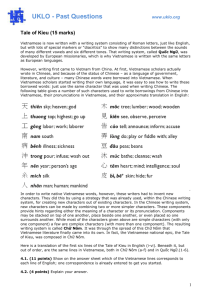
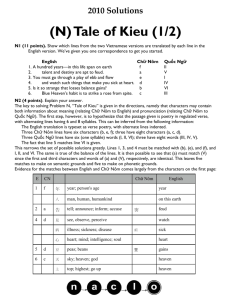
![vietnam[1].](http://s2.studylib.net/store/data/005329784_1-42b2e9fc4f7c73463c31fd4de82c4fa3-300x300.png)
